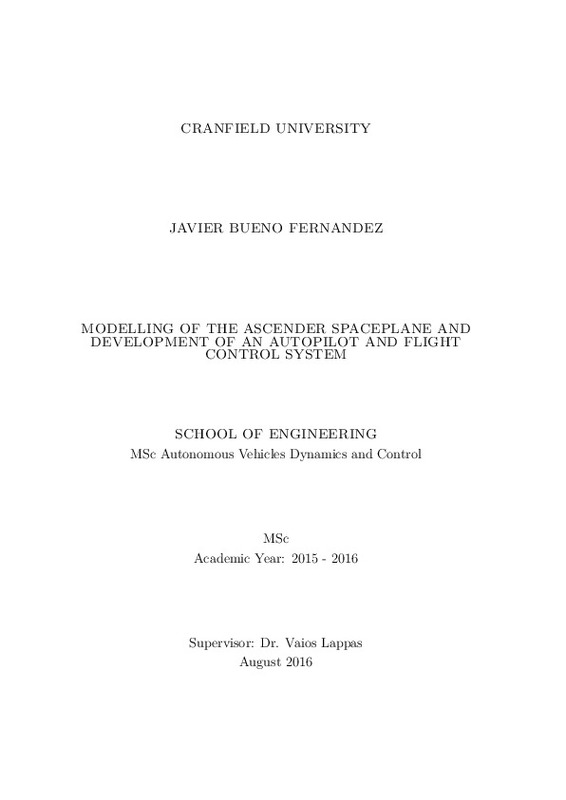|
Resumen:
|
[ES] El trabajo consiste en modelado en Simulink del avión espacial Ascender diseñado por la compañía británica Bristol Spaceplanes. Una vez se ha creado el model a través de los datos proporcionados por la compañía y una ...[+]
[ES] El trabajo consiste en modelado en Simulink del avión espacial Ascender diseñado por la compañía británica Bristol Spaceplanes. Una vez se ha creado el model a través de los datos proporcionados por la compañía y una serie de datos obtenidos de aviones semejantes, se procederá a la creación de un piloto automático para la fase turbojet del vuelo. En esta fase el piloto introduce una serie de waypoints, una altura de vuelo y una velocidad y el piloto automático se encarga de controlar el avión para conseguir dichos valores.
En cuanto a la fase cohete, un sistema de control de vuelo (también creado en Simulink como el modelo del avión y el piloto automático) se encargar de controlar el ángulo de trepada y el numero de Mach.
Por ultimo, un sistema de thrusters serán modelados y utilizados posteriormente para controlar la actitud del avión cuando no existe propulsion y el mismo se encuentra en su altura maxima (100 kilómetros). Todos los sistemas sera probado a través de una simulación de la misión completa que debe realizar el avión, la cual se encuentra detallada en la pagina web de la compañía.
[-]
[EN] The spaceplanes have been a feasible option to cut prices on the space missions. Because of their capability to be totally reusable, they can perform even more than one flight per day, launching small satellites in ...[+]
[EN] The spaceplanes have been a feasible option to cut prices on the space missions. Because of their capability to be totally reusable, they can perform even more than one flight per day, launching small satellites in LEO orbits or carrying space tourists, which has become a very profitable market.
The goal of this thesis is to develop a mathematical model of Ascender, a spaceplane designed by Bristol Spaceplanes. The mode will be created in Simulink, which provides a set of very useful tools in the aerospace field to simulate and create the model. The geometric data of the aircraft will be obtained from a 3D view map provided by the company, which will also be the basis to estimate the inertia moments, weights and gravity center.
Around the aircraft model, a set of controllers will be created, each one operating in a different phase according to the propulsion system used in them (turbojet, rocket or thrusters). In the case of the turbojet, a proper autopilot will be designed which will enable the pilot to command an altitude, a speed and a waypoint route for Ascender to follow. In the rocket phase, the flight path angle and the Mach number will be controlled to obtain a suitable climb a limit the demand over the aircraft structure. Finally, during the unpowered phase (climb and glide back to Earth), the thruster will control the spaceplane attitude to facilitate the launch of the payload and to improve the comfort of the passengers.
Al the control systems will be checked through their response to the different commands sent to them, so the time history of the controlled variables will be plotted to assure a good performance.
Finally, a simulation of the whole flight of Ascender from a trim state at 4000 meters to the point where the turbojet starts again to help in the landing, will be carried out and the system variables will be monitored to guarantee a good system behaviour.
[-]
|







